Teeth whitening has become a popular cosmetic procedure, with many people seeking brighter smiles through various whitening treatments. While many individuals achieve immediate results, some may notice that their teeth appear yellow or discolored shortly after the whitening process. This phenomenon can be surprising and frustrating for those seeking a brighter smile. In this article, we will explore the reasons why teeth can become yellowed after whitening, the factors that influence this process, and how to maintain a bright smile after treatment.
Understanding Teeth Whitening
What is Teeth Whitening?
Teeth whitening refers to the process of lightening the color of teeth to enhance their appearance. This can be achieved through several methods, including:
In-office whitening: Professional treatments performed by dentists using stronger bleaching agents.
At-home whitening kits: Over-the-counter products that often contain lower concentrations of bleaching agents.
Natural remedies: Methods such as baking soda, activated charcoal, or hydrogen peroxide.
How Do Whitening Products Work?
Most teeth whitening products contain active ingredients such as hydrogen peroxide or carbamide peroxide. These compounds penetrate the enamel and dentin layers of the teeth, breaking down stains and discoloration. While effective, these agents can also lead to changes in the tooth structure that may contribute to yellowing after treatment.
Reasons for Yellowing After Whitening
1. Enamel Erosion
One of the primary reasons teeth may appear yellow after whitening is enamel erosion. Enamel is the hard, protective outer layer of teeth. When exposed to acidic substances in whitening products, the enamel can wear away over time.
How Enamel Erosion Contributes to Yellowing
Exposure of Dentin: Beneath the enamel lies dentin, a yellowish tissue that gives teeth their color. When enamel erodes, the dentin becomes more visible, leading to a yellow appearance.
Increased Porosity: Eroded enamel may become more porous, allowing stains and discoloration to penetrate more easily.
This can result in a yellowish tint after whitening.
2. Rebound Effect
After a whitening treatment, some individuals may experience a rebound effect, where the teeth may appear to darken or yellow shortly after the initial whitening.
Mechanism of the Rebound Effect
Stain Absorption: After whitening, teeth may be more susceptible to absorbing stains from food and beverages. This is particularly true if individuals consume staining substances, such as coffee, tea, or red wine, shortly after treatment.
Dehydration of Teeth: Whitening treatments can temporarily dehydrate the teeth. Once the teeth rehydrate, they may appear darker due to changes in light reflection and the visibility of internal stains.
3. Inconsistent Application
Inconsistent application of whitening products can lead to uneven results, including yellowing in certain areas.
Factors Leading to Inconsistent Application
Improper Use of At-Home Kits: Many at-home whitening kits require careful application. If the product is not applied evenly, some areas may not whiten as effectively, leading to a patchy appearance.
Professional Treatment Limitations: Even with professional treatments, factors such as the concentration of the whitening agent and the duration of exposure can affect results. Inconsistent application can lead to uneven whitening and yellowing in certain areas.
4. Diet and Lifestyle Choices
After whitening, dietary and lifestyle choices can significantly affect the longevity of results.
Foods and Beverages That Contribute to Yellowing
Staining Foods: Consuming foods that are known to stain teeth, such as berries, sauces, and colored drinks, can lead to discoloration after whitening.
Acidic Foods and Drinks: Citrus fruits and sodas can erode enamel, making teeth more susceptible to yellowing.
5. Age and Natural Aging Process
As individuals age, their teeth naturally change color. This is a gradual process that can contribute to yellowing, even after whitening treatments.
How Aging Affects Tooth Color
Enamel Thinning: With age, enamel may become thinner, exposing more dentin and leading to a yellow appearance.
Intrinsic Staining: Over time, teeth may accumulate intrinsic stains from various sources, including medications and natural wear.
How to Maintain Whiteness After Whitening
1. Follow Post-Treatment Care Instructions
After undergoing a whitening treatment, it is essential to follow your dentist’s post-treatment care instructions. This may include:
Avoiding Staining Foods and Beverages: Limit the intake of coffee, tea, red wine, and dark-colored foods for at least 48 hours after treatment.
Using a Straw: When consuming beverages that may stain, using a straw can help minimize contact with teeth.
2. Practice Good Oral Hygiene
Maintaining good oral hygiene is crucial for keeping teeth white after whitening treatments.
Key Oral Hygiene Practices
Regular Brushing and Flossing: Brush at least twice a day and floss daily to remove plaque and prevent stains.
Whitening Toothpaste: Consider using a whitening toothpaste that is gentle on enamel and helps maintain brightness.
3. Schedule Regular Dental Cleanings
Regular visits to the dentist for professional cleanings can help remove surface stains and maintain the brightness of your smile.
4. Consider Touch-Up Treatments
If you notice yellowing after whitening, consider touch-up treatments. These can be done using at-home kits or professional treatments to restore brightness.
Conclusion
Teeth whitening can provide a brighter smile, but it is not without its challenges. Yellowing after whitening can occur due to several factors, including enamel erosion, the rebound effect, inconsistent application, dietary choices, and the natural aging process. Understanding these factors can help individuals make informed decisions about their whitening treatments and maintain their results.
To achieve and maintain a bright smile, it is essential to follow post-treatment care instructions, practice good oral hygiene, and schedule regular dental check-ups. By taking these steps, individuals can enjoy the benefits of teeth whitening while minimizing the risk of yellowing and other potential issues.
Related topics:

